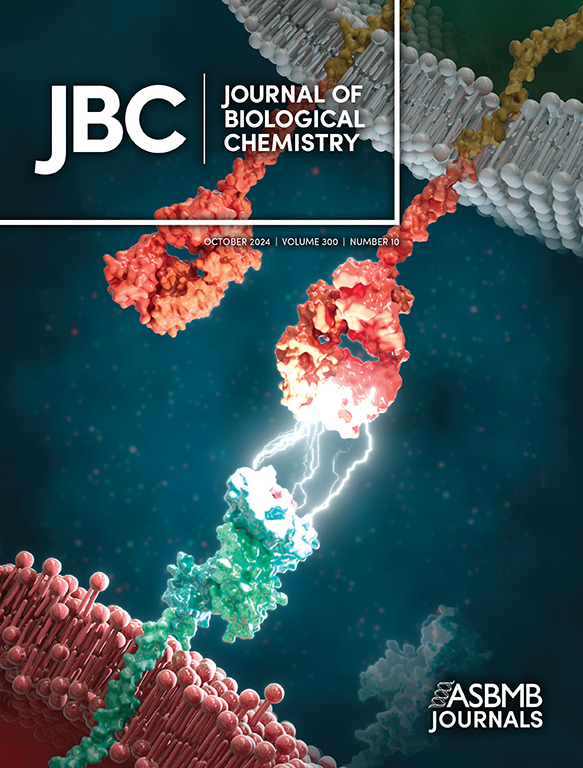罗丹明phalloidin标记的肌动蛋白丝荧光强度的时空波动。
IF 4
2区 生物学
Q2 BIOCHEMISTRY & MOLECULAR BIOLOGY
引用次数: 0
摘要
Phalloidin被广泛用于肌动蛋白纤维的荧光标记。我们在体外观察了罗丹明-phalloidin或Alexa488-phalloidin标记的ADP-actin丝,发现沿丝的荧光强度呈亮暗斑驳的模式。用亚化学计量罗丹明-phalloidin标记的细丝比过量罗丹明-phalloidin标记的细丝表现出更显著的荧光不均匀性。由于Alexa488荧光的量子产率几乎不受环境的影响,我们得出结论,这种不均匀性是由非均匀的phalloidin结合密度引起的,而不是由荧光团的局部不均匀量子产率引起的。模拟假设随机罗丹明-phalloidin单独结合部分产生荧光不均匀性,但不均匀程度明显小于实验结果。此外,罗丹明-phalloidin和Alexa488-phalloidin共标记的细丝在罗丹明和Alexa488的荧光强度上呈正相关。此外,Pi的加入抑制了荧光不均匀性和罗丹明与Alexa488荧光强度的相关性。这些结果表明,导致phalloidin结合密度不均匀的机制有两个:(1)随机结合;(2)肌动蛋白丝的pi敏感结构多态性导致phalloidin结合亲和力的局部差异。这种结构多态性也可能影响各种肌动蛋白结合蛋白的结合,促进体内肌动蛋白丝的功能分化。此外,这些斑驳的荧光模式随时间动态波动。这些时间荧光波动需要葡萄糖和葡萄糖氧化酶,但被Trolox抑制,可能反映了受氧清除剂和三态猝灭剂影响的荧光团的光物理性质。综上所述,我们为肌动蛋白丝的结构多态性提供了新的见解。本文章由计算机程序翻译,如有差异,请以英文原文为准。
Spatiotemporal fluctuations in fluorescence intensity of rhodamine phalloidin-labeled actin filaments.
Phalloidin is widely used for fluorescent labeling of actin filaments. We observed ADP-actin filaments labeled with rhodamine-phalloidin or Alexa488-phalloidin in vitro and discovered that the fluorescence intensities along the filaments showed a mottled pattern of bright and dark regions. Filaments labeled with sub-stoichiometric rhodamine-phalloidin exhibited more significant fluorescence inhomogeneities than those labeled with excess rhodamine-phalloidin. Because the quantum yield of Alexa488 fluorescence is hardly affected by the environment, we concluded that the inhomogeneities arise from non-uniform phalloidin binding density rather than locally inhomogeneous quantum yield of the fluorophores. Simulations assuming random rhodamine-phalloidin binding alone partially produced fluorescence inhomogeneities, but the degree of inhomogeneities was significantly smaller than the experimental results. Furthermore, filaments co-labeled with rhodamine-phalloidin and Alexa488-phalloidin showed a positive correlation in fluorescence intensities of rhodamine and Alexa488. Moreover, addition of Pi suppressed the fluorescence inhomogeneities and the correlation between the rhodamine and Alexa488 fluorescence intensities. These results indicated that two mechanisms contribute to the non-uniform binding density of phalloidin: (i) stochastic binding and (ii) local differences in phalloidin binding affinity caused by Pi-sensitive structural polymorphism of actin filaments. This structural polymorphism may also affect the binding of various actin-binding proteins, contributing to the functional differentiation of actin filaments in vivo. Moreover, those mottled fluorescence patterns dynamically fluctuated over time. These temporal fluorescence fluctuations required glucose and glucose oxidase but were suppressed by Trolox, likely reflecting photophysical properties of fluorophores influenced by oxygen scavengers and triplet-state quenchers. Taken together, we provide new insights into the structural polymorphism of actin filaments.
求助全文
通过发布文献求助,成功后即可免费获取论文全文。
去求助
来源期刊

Journal of Biological Chemistry
Biochemistry, Genetics and Molecular Biology-Biochemistry
自引率
4.20%
发文量
1233
期刊介绍:
The Journal of Biological Chemistry welcomes high-quality science that seeks to elucidate the molecular and cellular basis of biological processes. Papers published in JBC can therefore fall under the umbrellas of not only biological chemistry, chemical biology, or biochemistry, but also allied disciplines such as biophysics, systems biology, RNA biology, immunology, microbiology, neurobiology, epigenetics, computational biology, ’omics, and many more. The outcome of our focus on papers that contribute novel and important mechanistic insights, rather than on a particular topic area, is that JBC is truly a melting pot for scientists across disciplines. In addition, JBC welcomes papers that describe methods that will help scientists push their biochemical inquiries forward and resources that will be of use to the research community.
 求助内容:
求助内容: 应助结果提醒方式:
应助结果提醒方式:


